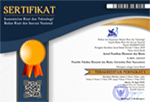How does Unified Theory of Acceptance and Use of Technology (UTAUT) Work on Adopting Financial Technology (FinTech) by MSMEs?
DOI:
https://doi.org/10.33633/jpeb.v6i2.4826Abstract
Micro Small and Medium Enterprises (MSMEs) have a very significant role in the economy, can even be said to be the backbone of the economy. However, MSMEs are precisely the sector hardest hit by the Covid-19 pandemic. Digitalization creates new opportunities for MSMEs in the pandemic. FinTech, one of the implementations of digitalization should be pursued to be used by MSMEs. Using path analysis processed using Partial Least Square (PLS), this research aims to identify how Unified Theory of Acceptance and Use of Technology (UTAUT) works on Adopting FinTech by MSMEs. The Outer Model and Inner Model reflect that the model work. The outer loading value of ? 0.7, AVE value ? of 0.5, Cronbach's Alpha ? 0,70, a correlation value ? of 0.50; and Composite Reliability ? 0.6, and R-Square 0.716 reflect it. However, regarding the factors that influence intention to use, it is different from previous research that became a reference. There are only four hypotheses proven. Those are Context had a significant positive effect on Perceived Ease of Use and Perceived Usefulness, and Perceived Ease of Use and Perceived Usefulness had a significant positive effect on the intention to use fintech. Keywords: FinTech, MSMEs, Digitalization, UTAUT, InclusiveReferences
Ajzen, I. (1991). Ajzen, I. (1991). The theory of planned behavior. Organizational Behavior and Human Decision Processes.The theory of planned behavior. In Organizational Behavior and Human Decision Processes.
Aryanto, V.D.W., Wismantoro, Y dan Widyatmoko, K. 2018. Implementing Eco-Innovation by Utilizing the Internet to Enhance Firm's Marketing Performance: Study of Green Batik Small and Medium Enterprises in Indonesia. International Journal of e-Business Research. 14(1). 21- 36.
Bappenas. (2020). Kajian Kebijakan Penanggulangan Dampak COVID-19 terhadap UMKM Survei Kebutuhan Pemulihan Usaha Bagi UMKM Indonesia. Bappenas.
Barua, A., Pinnel, J., & Shutter. 2001. Measuring the Internet economy. Retrieved from http://ai.kaist. ac.kr/jkim/cs492a/internet_economy- UT.pdf.
Birkin, S. J., and Harris, M. L. 2003. E-Business and CRM: Directions for the Future. In Proceedings of the International Association for the Development of Information Systems (IADIS) Conference. Carvoeiro, Portugal, 5–8 November, pp. 121–8.
Blanchflower, D. G. (2000). Self-employment in OECD countries. Labour Economics. https://doi.org/10.1016/S0927-5371(00)00011-7
Bloch, M., Pigneur, Y., &Sergev, A. 2006. On the road of electroniccommerce- a business value framework, gaining competitive advantage and some research issues. Laussane, Swizterland: University of Laussane.
Chia Cua, F., & Garrett, T. C. (2010). Diffusion of Innovations Theory. In Handbook of Research on Contemporary Theoretical Models in Information Systems. https://doi.org/10.4018/978-1-60566-659-4.ch014
Eisingerich, A. B., & Rubera, G. (2010). Drivers of Brand Commitment: A Cross-. National Investigation. Journal of International Marketing, 18(2), 64–79.Davis, F. D. (1989). Perceived usefulness, perceived ease of use, and user acceptance of information technology. MIS Quarterly: Management Information Systems. https://doi.org/10.2307/249008
Gao, S., Krogstie, J., & Siau, K. (2011). Developing an instrument to measure the adoption of mobile services. Mobile Information Systems. https://doi.org/10.3233/MIS-2011-0110
Ghozali., I. 2013. Aplikasi Analisis Multivariate dengan Program IBM SPSS 19. Edisi 5. Penerbit Universitas Diponegoro: Semarang
Hair, Jr et.al. (2010). Multivariate Data Analysis (7th ed). United States : Pearson
Haltiwanger, J., &Jarmin, R. S. 2000. Measuring the digital economy. Cambridge, MA: MIT Press.
Indonesia, K. K. R. (2020). Dirjen PPI: Survei Penetrasi Pengguna Internet di Indonesia Bagian Penting dari Transformasi Digital.
Jogiyanto, & Abdillah, W. (2009). Konsep dan Aplikasi PLS (Partial Least Square) untuk Penelitian Empiris. Yogyakarta
Kementerian Keuangan. (2020). Program Pemulihan Ekonomi Nasional. Kementerian Keuangan.
Kenney, M., & Curry, J. 2000. Beyond transac tion cost: E-commerce and the power of Internet dataspace. Berkeley, CA: University of California.
Kling, R., & Lamb, R. 1999. IT and the organiza tional change in digital economies: A socio technical approach. Paper presented at the Conference on Understanding the Digital Economy: Data, Tools and Research, Washington, DC.
Masurel, E. (2007). Why SMEs invest in environmental measures: Sustainability evidence from small and medium-sized printing firms. Business Strategy and the Environment. https://doi.org/10.1002/bse.478
OECD. (2000). Korea and the Knowledge-based Economy: Making the Transition. World.
OECD. (2016). Automation and independent work in a digital economy. Policy Brief on the Future of Work.
Rogers, E. M., Singhal, A., & Quinlan, M. M. (2019). Diffusion of innovations. In An Integrated Approach to Communication Theory and Research, Third Edition. https://doi.org/10.4324/9780203710753-35 Tapscott, D. 1998. The digital economy: Promise and peril in the age one worked intelligence. New York, NY: Mc-Graw Hill.
Wu, C. S., Cheng, F. F., Yen, D. C., & Huang, Y. W. (2011). User acceptance of wireless technology in organizations: A comparison of alternative models. Computer Standards and Interfaces. https://doi.org/10.1016/j.csi.2010.03.002
Zimmermann, H. D., &Koerner, V. 2000. Management of customer relationship in the business media: The case of financial industry: New emerging industrial structures in the digital economy. Paper presented at the Conference on Information Systems, Milwaukee, WI.
Zysman, H., & Weber, S. 2000. Governance and politics of the Internet economy: Historical transformation or ordinary politics with a new vocabulary? In International Encyclopedia of the Social & Behavioral Sciences. Oxford, UK: Elsevier
Downloads
Published
How to Cite
Issue
Section
License
The copyright of the received article shall be assigned to the journal as the publisher of the journal. The intended copyright includes the right to publish the article in various forms (including reprints). The journal maintains the publishing rights to the published articles.
This work is licensed under a Creative Commons Attribution 4.0 International License.


.png)









